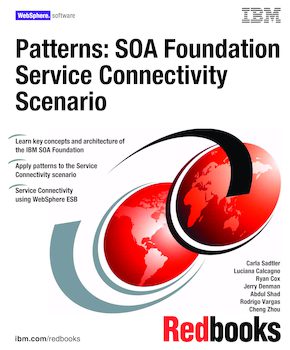Patterns: SOA Foundation Service Connectivity Scenario
An IBM Redbooks publication
Note: This is publication is now archived. For reference only.

Published on 17 August 2006
ISBN-10: 0738495964
ISBN-13: 9780738495965
IBM Form #: SG24-7228-00
Authors: Carla Sadtler, Luciana Calcagno, Ryan Cox, Jerry Denman, Abdul Shad, Rodrigo Vargas and Cheng Zhou
The IBM SOA Foundation is a reference architecture used to build new applications or extend the value of existing applications and business processes. The IBM SOA Foundation includes an integration architecture, best practices, patterns, and SOA scenarios to help simplify the packaging and use of IBM open standards-based software.
A set of SOA scenarios is being developed by IBM that describe key architectural scenarios for SOA solutions and bridge the gap between SOA and the IBM products that can be used to implement these architectures.
This IBM Redbooks publication focuses on the Service Connectivity scenario, which describes architectural solutions using an ESB. The focus of this scenario is the integration of service consumers and service providers across multiple channels.
Chapter 1. IBM SOA Foundation
Chapter 2. Process for applying SOA scenarios
Chapter 3. Patterns for e-business and Service Connectivity
Chapter 4. Planning for connectivity
Chapter 5. Model with Rational Software Architect
Chapter 6. Assemble with WebSphere Integration Developer
Chapter 7. Building the Credit Rating and Credit Score mediations
Chapter 8. Building the CRM mediation
Chapter 9. Building the Register Shipping mediation
Chapter 10. Building Log Registration mediation
Chapter 11. Deploy with WebSphere ESB
Chapter 12. Service monitoring and management with IBM Tivoli Composite Application Manager SOA
Appendix A. Sample application install summary
Appendix B. Tips and techniques
Appendix C. Installation details
Appendix D. Additional material